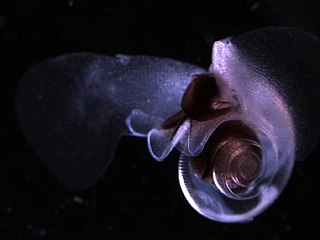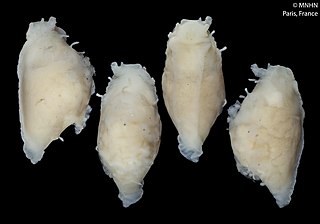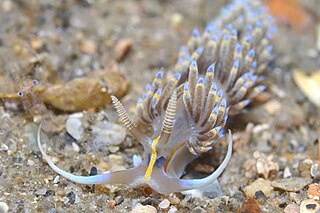
Limacina is a genus of swimming predatory sea snails commonly known as sea butterflies in the family Limacinidae. This genus contains some of the world's most abundant gastropod species.

Cymbuliidae is a family of pelagic sea snails or "sea butterflies", marine gastropod mollusks in the superfamily Cymbulioidea.
The Cliopsidae, common name sea angels, are a taxonomic family of small, free-swimming sea slugs, pelagic marine opisthobranch gastropod mollusks in the order Opisthobranchia.
The Notobranchaeidae, or "naked sea butterflies", are a taxonomic family of floating sea slugs, specifically under the subclass Opistobranchia, also called "sea angels".

Fiona pinnata, common name Fiona, is a species of small pelagic nudibranch, a marine gastropod mollusk in the superfamily Fionoidea. This nudibranch species lives worldwide on floating objects on seas, and feeds mainly on barnacles, specifically goose barnacles in the genus Lepas.

Elysia timida is a species of sacoglossan sea slug, a marine opisthobranch gastropod mollusk. Found in the Mediterranean and nearby parts of the Atlantic, it is herbivorous, feeding on various algae in water.

Haminoea is a genus of medium-sized sea snails or bubble snails, marine opisthobranch gastropod molluscs in the family Haminoeidae, the haminoea bubble snails, part of the clade Cephalaspidea, the headshield slugs and bubble snails.

Chromodoris michaeli is a species of colourful sea slug, a dorid nudibranch, a marine gastropod mollusk in the family Chromodorididae.

Felimida krohni is a species of colorful sea slug, a dorid nudibranch, a marine gastropod mollusc in the family Chromodorididae. This species occurs in European waters and in the Mediterranean Sea (Greece). The specific name krohni was in honour of Russian zoologist August David Krohn.

Gaza is a genus of sea snails, marine gastropod mollusks in the family Margaritidae.
Hypselodoris babai is a species of colourful sea slug or dorid nudibranch, a marine gastropod mollusc in the family Chromodorididae.
Corolla is a genus of pelagic "sea butterflies". These are holoplanktonic opisthobranch molluscs belonging to the family Cymbuliidae. They are preyed upon by the gymnosome pteropods of the genus Cliopsis.

Acteon tornatilis, common name the "lathe acteon", is a species of medium-sized sea snail, a predatory marine gastropod mollusc in the family Acteonidae, the barrel bubble snails.

Okenia zoobotryon is a species of sea slug, a dorid nudibranch, a marine gastropod mollusc in the family Goniodorididae. It is normally found on the colonial bryozoan Amathia verticillata on which it lives and feeds.

Berghia stephanieae is a species of sea slug, an aeolid nudibranch. It is a marine gastropod mollusc in the family Aeolidiidae. It was previously known as Aeolidiella stephanieae.
Chromodoris tenuis is a species of colourful sea slug, a marine gastropod mollusk, a nudibranch in the family Chromodorididae. The scientific name of the species was first published in 1881 by Collingwood.

Calmella cavolini is a small aeolid, with a maximum length of 12mm. It has smooth elongate rhinophores, oral tentacles, and angular anterior foot corners. Cerata, with a common stalk each, are arranged in groups. The front 3 ceratal clusters, which are on each side, are oppositely arranged but the posterior 3 ceratal clusters are arranged alternately. The color of digestive gland duct is bright red but the apical cnidosac is white in color. The jaw plates are purplish red and they show through each side of the slug's head as a reddish color spot. It was reported that it feeds on the hydroid, Eudendrium.

Dondice occidentalis is a species of sea slug, an aeolid nudibranch, a marine gastropod mollusk in the family Facelinidae.

Doto chica is a species of sea slug, a dendronotid nudibranch, a marine gastropod mollusc in the family Dotidae.
Aglaja tricolorata is a species of sea slug, an opisthobranch gastropod mollusc in the family Aglajidae. It is native to the Mediterranean Sea and the tropical eastern Atlantic Ocean where it lives in shallow water on the sandy seabed.














